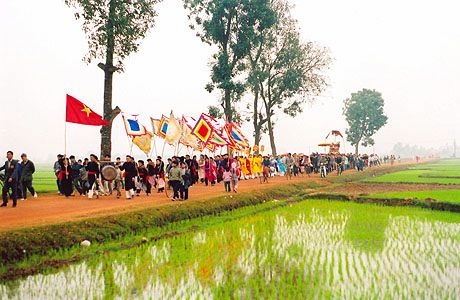Elderly overseas Vietnamese Tran Thi Dy and her group from the US returned to Vietnam last week after nearly 30 years from the country.
Dy, 70, said her group plans to tour Hanoi\'s tourism sites including one of its three ancient villages: Nghi Tam, which was once known as a flower village.
| Echoes from the past: Kim Lien (Golden Lotus) Pagoda, built in 1771 during the reign of King Ly Than Tong, in Nghi Tam Village is said to be one of the most sacred pagodas in Ha Noi |
Dy said she was looking forward to joining the annual Nghi Tam Festival which takes place next Thursday and is expected to attract thousands of people.
The village is changing rapidly as villas and high-storied buildings have mushroomed, said Dy, adding that she was really interested in visiting Nghi Tam\'s Kim Lien Pagoda and Nghi Tam Communal House which were built during the Ly (1025-1225) dynasty.
"We felt very spiritual visiting the pagodas, and they look good since their facelifts. At these sites we prayed for good health and a lucky year. The sites are a valuable part of Ha Noi\'s heritage because they are related to the establishment and development of Thang Long, now Ha Noi," said Dy, who grew up in the city.
A local villager, Nguyen Thi Yen said villagers are very proud of the pagoda because it honours six village tutelary saints compared with three which are common at other temples.
One of the honoured saints represents Princess Tu Hoa who had spent her time farming silk cocoons in large mulberry fields.
"We all are aware that we must preserve these sites because they are the soul of our village," said Yen.
Nghi Tam is famous nationwide for its traditional occupations of flower and bonsai growing and ornamental fish farming.
Bonsai have been grown in Nghi Tam since 1228 when a villager bought saplings from a Chinese trader to plant in his village.
Bonsai lovers throughout Ha Noi are well aware of the century-old Nghi Tam bonsai trees.
Unfortunately, urbanisation has encroached on the land used to grow bonsai, elderly Hoang Thi Thuan said, adding half of her 1,000sq.m land has been used for such a purpose.
About 70 per cent of the land in the village is now occupied by villas for rent with prices ranging from US$700 to $1,500 a month, said Thuan.
But her family members agreed that they have to keep their family tradition of growing flowers and bonsai trees alive.
Thuan said her family earns between VND150,000 and VND200 million from bonsai trees, kumquat and peach trees every year.
Hoang Van An\'s family raises pet fish for sale.
"In the past half of our village used to raise ornamental fish for sale in the capital and surrounding provinces, but now only a few households continue because of the low returns," said An.
 |
| Join the procession: Hundreds of Hanoians and tourists joined a flag procession during last year\'s Nghi Tam Festival. |
He said, despite the meagre earnings, he loves the job that was handed down from his grandfather, and he loves working with his colourful pet fish.
"I\'m very happy because we\'ve had the chance to welcom many local and foreign tourists when they visit our village. I have the chance to introduce all the different varieties of ornamental fish to them. Many foreigners working in Viet Nam have bought ornamental fish to raise at home," said An.
Nghi Tam has been a flower village since the establishment of the capital. The village has developed continuously, and has always been considered as one of the largest flower villages, supplying fresh flowers for the city and its vicinity. In the 1950s, nearly all the households were involved in planting flowers.
There are many kinds of flowers originating from temperate regions like the peach blossom, daisy, violet and lily, and particularly the kumquat, peach and while apricot. From winter to spring, with the drizzling rain and the cold wind, the temperature is suitable for the growth of these flowers. Every morning, Nghi Tam flower market is busy.
Hanoians take the utmost care in the selection of their Tet (Lunar New Year) peach trees, taking into account every tiny detail that must sit in harmony with the sentiment or philosophy that one wishes to express, in addition to matching the interior decoration of their house.
Kumquat is another species that spread from Nghi Tam Village to West Lake. During Tet, most families in the capital, and now throughout the country, have their kumquat trees to symbolise talent and wealth.
Nghi Tam arose in 1138 during the reign of King Ly Than Tong. The site of the village was home to his Tam Tang estate which later the King gave to his daughter Princess Tu Hoa. She led the village in farming silk cocoons on large mulberry fields, creating an occupation the capital Thang Long was famous for at that time.
During the Tran (1225-1400) dynasty the estate\'s name was changed to Tich Ma and then finally Nghi Tam during the Le (1428-1788) dynasty.
Nghi Tam is also the native village of Ba Huyen Thanh Quan, a 19th-century female poet whose work is still admired today.
A stone stele honouring the poetess is still preserved by a family of her lineage.

Leave your comment on this story